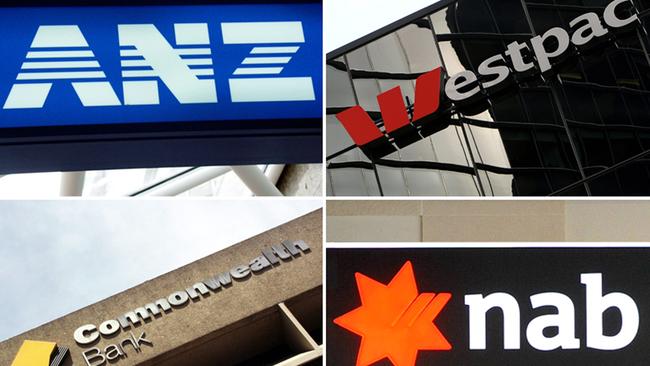Big banks sitting on a potential $6bn bonus if the nation’s economic resilience continues
Australia’s big banks are holding on to $6bn in excess provisions for bad loans, but the economy’s resilience means this money may never be used and could instead be booked as profit.

The nation’s big banks are sitting on a potential $6bn treasure trove, stashed away as provisions for bad loans that may never materialise if the economy continues to defy expectations.
Part of the banks’ “fat” bad debt provisions could become instant profits if the economy stays strong, but that is “the million dollar question”, Pengana Capital chief investment officer Rhett Kessler said.
“The real wildcard is what is the true bad debt experience actually going to be? Because at the moment, it’s been very positive. And so if it turns negative, that will really affect returns on equity,” Mr Kessler said.
With strategists and economists now expecting several interest rate cuts this year, the cycle of bad debts could be closer to its peak than previously expected.
“That’s the question that I am constantly asking myself: where does that bad debt for the life of the loan actually end up? I never thought bad debts would hold up as well, but they have – it’s been amazing,” Mr Kessler said.
“CBA and NAB have been more worried about it than I am and have made provisions accordingly. So if our fears are realised, I think they’ve provided for it. If they aren’t realised, I think there’s enormous fat in the system for those banks.”
All of the major banks, which also include Westpac and ANZ, have in excess of $1.5bn in provisions above their respective base case expectations, according to an analysis by JPMorgan.
The broker said the banks have factored a probability of about 45 per cent to a meaningful downside economic scenario, which is increasingly unlikely to eventuate.
Commonwealth Bank, the nation’s largest, had set aside $6bn to cover potential loan losses as of September last year, equivalent to 1.65 per cent of its risk weighted assets (RWA) and up from $5.2bn in 2022.
That was nearly double the amount in 2018 ($3.6bn), before accounting changes required provisions to include a collective estimate based on their future economic forecasts, which bumped them to $4.8bn in 2019.
During the 2020 pandemic, provisions jumped to $6.4bn, equivalent to 1.7 per cent of RWA, up from 1.29 per cent in 2019.
Part of that was reversed in 2021 and 2022, resulting in lower bad debt expenses that partly led to higher profitability and return on equity metrics.
Yet, as of September last year, the proportion of home loan customers behind on their repayments at CBA had edged only slightly higher to 0.49 per cent, up from 0.47 per cent in June. That June 2023 level was actually below June 2022 (also 0.49 per cent), a month after the RBA began the most aggressive interest rate rising cycle in May of that year.

With the economy slowing down after 13 interest rate increases since May 2022, but travelling better than expected with a still strong labour market and potentially avoiding recession, investors are starting to account for the potential reversal of bad debt provisions into the bank’s earnings.
“There is a focus on the potential and extent for bad debt provisions to be written back (into profits), because the downside scenarios are not playing out, as some have expected,” said Andrew Triggs, who leads the banking research team in Australia at JPMorgan.
“The big four majors are putting a 45 per cent probability weighting on downside economic scenarios, which look difficult to justify, given the current macroeconomic conditions.”
Instead, Mr Triggs said he expected “this period of economic stability to continue”, which meant there were now “better chances of the majors winding back collective provisions, even if modestly,” he said. This is being reflected in bank’s share prices, with Commonwealth Bank shares this week reaching a record price of $118.24. This is equivalent to 20.5 times the earnings per share forecast by analysts, according to data provider Visible Alpha.
CBA’s downside scenario is for a sharp increase in the unemployment rate to 8.5 per cent this year, up from 3.9 per cent currently. That would then rise to 8.9 per cent next year.
It also assumes the cash rate rising from 4.35 per cent to 5.4 per cent this year to bring down price inflation of 8 per cent, double the most recent annual rate of 4.1 per cent in the December quarter.
The bank’s central scenario used for its provisions still sees the unemployment rate rising to 4.4 per cent this year, and 4.5 per cent in 2025.
CBA will update those forecasts when it announces interim results on February 14.
At National Australia Bank, the nation’s main provider of financing to businesses, provisions for bad debts total $5.6bn, up from $5bn a year earlier.
With an excess of $1.6bn relative to their base forecasts, JPMorgan estimates the Melbourne-based lender has the highest excess relative to its book, which the broker said was appropriate given its higher exposures to the small and medium sized business (SME) sector.
NAB’s downside scenario forecasts a 1.2 per cent fall in economic activity this year, as opposed to the 0.8 per cent economic growth expected by its base case scenario. Unemployment would then rise to 4.7 per cent and house prices would tumble 24 per cent.
JPMorgan’s Mr Triggs said: “All the majors have high collective provision balances compared to pre-Covid levels and in our view are well positioned if an increase in customer stress were to eventuate. “However, we are forecasting a normalisation of impairments to just under pre-Covid levels to an average of 13 basis points of gross loans for the major banks in the 2024 financial year.”
Westpac is carrying $1.5bn in excess provisions relative to its central scenario, while ANZ has set aside an extra $2.2bn, according to JPMorgan.
However, ANZ uses a different methodology, which makes its base case scenario provision of $1.8bn look relatively low to the other three, which have base case provisions of $3.4bn (Westpac), $3.8bn (Commonwealth Bank) and $4bn (NAB).







To join the conversation, please log in. Don't have an account? Register
Join the conversation, you are commenting as Logout